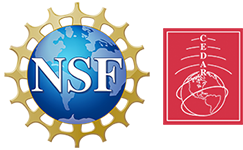2025 Workshop: Hazards
Björn Bergsson (ERAU)
Pavel Inchin (CPI)
Hyunju Connor (NASA)
Yue Deng (UTA)
Irfan Azeem (NOAA)
Sharon Vadas (NWRA)
Synoptic atmospheric hazards, such as hurricanes and strong frontal activity, and defined geological hazards, such as seismic and volcanic activities, can trigger acoustic and gravity waves that propagate upwards and can be detected in the upper atmosphere. Additionally, man-made artificial, accidental, and intentional explosive events are also equally responsible for generating shock or acoustic wave signatures in the geospace environment. Observation and modeling of these events can give new insights into our understanding of the dynamics, chemistry, and fundamental coupling processes between the troposphere and the middle and upper atmosphere. In system theory, such lower atmospheric events can be thought of as a defined input, x(t), into a complex system, h(t), where the CEDAR/GEM community can observe y(t) and gain insight on the fundamental transfer function(s) representing the underlying physical processes controlling the upper atmospheric response. This workshop welcomes short interactive presentations on the upper atmospheric response to various natural and artificial phenomena occurring in the oceans, on land, and in the lower atmosphere. Such phenomena include but are not limited to, earthquakes, surface and submarine volcanic eruptions, tsunamis, typhoons, cyclones, hurricanes, tornados, thunderstorms, non-nuclear explosions, nuclear detonations, rocket exhausts, etc., which are studied from different observational and modeling approaches. Improved capabilities in forecasting these disasters can save hundreds of lives and protect billions of dollars in property from damage. Rapidly growing and practical automated processes, such as Artificial Intelligence (AI) and Machine Learning (ML), can analyze massive data sets, enabling scientists to gain new insights and optimize performance. These advancements are crucial for hazard-related preparedness and response. The workshop seeks to bring together the CEDAR and GEM communities from different disciplines and backgrounds so as to fundamentally develop a deeper understanding of the geophysical processes involved. It is anticipated that the impact of this activity can lead to new projects related to natural and artificial hazard-induced upper atmospheric dynamics, including research-based AI/ML tools that may lead to early warning systems against such disasters.
Date: Tuesday, June 24, 2025
Time: 10:00 - 12:00 CDT
Location: Room 319 – 320
Iowa Events Center, Convention Center
730 3rd Street, Des Moines, IA 50309
------------------------------------------------------------------------------
For Remote Participation:
Zoom Link: https://us06web.zoom.us/j/87504196255?pwd=bajUZCieKW1V81RNvkuqfAf6Du7zFk.1
Meeting ID: 875 0419 6255
Passcode: 062222
------------------------------------------------------------------------------
10:00-10:12 Xian Lu (Clemson University): Impacts of Thunderstorm-Generated Gravity Waves on the Ionosphere-Thermosphere Using TIEGCM-NG/MAGIC Simulations and Comparisons with GNSS TEC, ICON, and COSMIC-2 Observations
10:12-10:24 Yue Deng (University of Texas at Arlington): Impact of Geographic Events on the Ionosphere: GITM-R Simulations
10:24-10:36 Rafael Mesquita (Johns Hopkins University): Modeling Effects of the 2024 Total Solar Eclipse on Ground Magnetometer Networks
10:36-10:48 Larisa Goncharenko (MIT Haystack Observatory): Separating Natural and Anthropogenic Sources of Ionospheric Disturbances in the Russia-Ukraine Sector
10:48-11:00 Jonathan Snively (Embry-Riddle Aeronautical University): High-Fidelity Modeling for Atmosphere-Ionosphere Responses to Wave Signals (AIRWaveS)
11:00-11:12 Gian Luca Delzanno (Los Alamos National Laboratory): Radiation Belt Remediation via Injection of Plasma Waves
11:12-11:24 Denny M Oliveira (NASA Goddard Space Flight Center): Starlink Satellite Re-entries During the Ascending Phase of Solar Cycle 25
11:24-11:36 Paul Bernhardt (University of Alaska): Rocket Exhaust Induced Precipitation of Energetic Electrons into the D-Region from Amplified VLF Waves in the F-layer
11:36-11:48 Björn Bergsson (Embry-Riddle Aeronautical University): The Impact of Line-of-Sight Orientation on GNSS TEC Observations of AGW-Induced TIDs: Application to Geolocation of TID Sources
11:48-12:00 Sai Gowtam Valluri (NASA Goddard Space Flight Center): ML-based Auroral Particle Precipitation and Electrodynamics Modeling
A powerful submarine volcano (Hunga Tonga-Hunga Ha'apai) erupted in mid-January 2022 near the South Pacific Kingdom of Tonga. The event generated a tsunami and related ocean waves across the world. This violent explosion itself reached the near stratosphere, triggering an acoustic shockwave in the troposphere that was strong enough to generate waves that reached the Earth’s ionosphere. The geospace community is currently using this event to study the response function of the middle and upper atmosphere. The Tonga event, and more generally other synoptic geological, atmospheric, and artificial hazards, can generate atmospheric waves that can “ping” the upper atmospheric system. The impacts and consequences of such “perturbation or system theory” approach are not well understood, as the fundamental dynamics, chemistry, and coupling mechanisms are still poorly constrained. Besides observations, newly practiced AI/ML-based modeling is a critical tool for forecasting natural/artificial disasters. It approximates the real system’s behavior, raising awareness among the public as well as emergency responders. As such, it is an ideal time to hold a joint CEDAR/GEM workshop so as to enable the community to present, discuss, update, and improve our understanding of geological, atmospheric, and artificial hazard-related acoustic and gravity wave propagation and upper atmospheric responses. These efforts can be highlighted in various CEDAR strategic thrusts, specifically in Thrusts 1, 3, 5, and 6.
GEM Resource Group: Machine Learning (Chair: Hyunju Connor)
